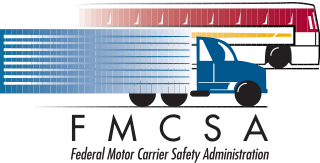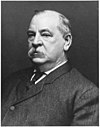The Elkins Act is a 1903 United States federal law that amended the Interstate Commerce Act of 1887. The Act authorized the Interstate Commerce Commission (ICC) to impose heavy fines on railroads that offered rebates, and upon the shippers that accepted these rebates. The railroad companies were not permitted to offer rebates. Railroad corporations, their officers, and their employees, were all made liable for discriminatory practices.

The Hepburn Act is a 1906 United States federal law that expanded the jurisdiction of the Interstate Commerce Commission (ICC) and gave it the power to set maximum railroad rates. This led to the discontinuation of free passes to loyal shippers. In addition, the ICC could view the railroads' financial records, a task simplified by standardized bookkeeping systems. For any railroad that resisted, the ICC's conditions would remain in effect until the outcome of legislation said otherwise. By the Hepburn Act, the ICC's authority was extended to cover bridges, terminals, ferries, railroad sleeping cars, express companies and oil pipelines.
The Mann–Elkins Act, also called the Railway Rate Act of 1910, was a United States federal law that strengthened the authority of the Interstate Commerce Commission (ICC) over railroad rates. The law also expanded the ICC's jurisdiction to include regulation of telephone, telegraph and wireless companies, and created a commerce court.
The Transportation Act, 1920, commonly known as the Esch–Cummins Act, was a United States federal law that returned railroads to private operation after World War I, with much regulation. It also officially encouraged private consolidation of railroads and mandated that the Interstate Commerce Commission (ICC) ensure their profitability. The act was named after Rep. John J. Esch and Sen. Albert B. Cummins.

The United States Department of Transportation is one of the executive departments of the U.S. federal government. It is headed by the secretary of transportation, who reports directly to the president of the United States and is a member of the president's Cabinet.

The Staggers Rail Act of 1980 is a United States federal law that deregulated the American railroad industry to a significant extent, and it replaced the regulatory structure that had existed since the Interstate Commerce Act of 1887.
The Railroad Revitalization and Regulatory Reform Act of 1976, often called the "4R Act," is a United States federal law that established the basic outlines of regulatory reform in the railroad industry and provided transitional operating funds following the 1970 bankruptcy of Penn Central Transportation Company. The law approved the "Final System Plan" for the newly created Conrail and authorized acquisition of Northeast Corridor tracks and facilities by Amtrak.
In the United States government, independent agencies are agencies that exist outside the federal executive departments and the Executive Office of the President. In a narrower sense, the term refers only to those independent agencies that, while considered part of the executive branch, have regulatory or rulemaking authority and are insulated from presidential control, usually because the president's power to dismiss the agency head or a member is limited.

The Safety Appliance Act is a United States federal law that made air brakes and automatic couplers mandatory on all trains in the United States. It was enacted on March 2, 1893, and took effect in 1900, after a seven-year grace period. The act is credited with a sharp drop in accidents on American railroads in the early 20th century.
Boynton v. Virginia, 364 U.S. 454 (1960), was a landmark decision of the US Supreme Court. The case overturned a judgment convicting an African American law student for trespassing by being in a restaurant in a bus terminal which was "whites only". It held that racial segregation in public transportation was illegal because such segregation violated the Interstate Commerce Act, which broadly forbade discrimination in interstate passenger transportation. It moreover held that bus transportation was sufficiently related to interstate commerce to allow the United States federal government to regulate it to forbid racial discrimination in the industry.

Wooden railroads, called wagonways, were built in what became the United States starting from the 1720s. A railroad was reportedly used in the construction of the French fortress at Louisburg, Nova Scotia, in New France in 1720. In 1762–1764, at the close of the French and Indian War (1756–1763), a gravity railroad, Montresor's Tramway, was built by British military engineers up the steep riverside terrain near the Niagara River waterfall's escarpment at the Niagara Portage in Lewiston, New York.

The Surface Transportation Board (STB) of the United States is an independent federal agency that serves as an adjudicatory board. The board was created in 1996 following the abolition of the Interstate Commerce Commission (ICC), and absorbed regulatory powers relevant to the railroad industry previously under the ICC's purview.

The Interstate Commerce Act of 1887 is a United States federal law that was designed to regulate the railroad industry, particularly its monopolistic practices. The Act required that railroad rates be "reasonable and just," but did not empower the government to fix specific rates. It also required that railroads publicize shipping rates and prohibited short haul or long haul fare discrimination, a form of price discrimination against smaller markets, particularly farmers in Western or Southern Territory compared to the official Eastern states. The Act created a federal regulatory agency, the Interstate Commerce Commission (ICC), which it charged with monitoring railroads to ensure that they complied with the new regulations.

The Federal Motor Carrier Safety Administration (FMCSA) is an agency in the United States Department of Transportation that regulates the trucking industry in the United States. The primary mission of the FMCSA is to reduce crashes, injuries, and fatalities involving large trucks and buses.
Title 49 of the United States Code is a positive law title of the United States Code with the heading "Transportation."

Sarah Keys v. Carolina Coach Company, 64 MCC 769 (1955) is a landmark civil rights case in the United States in which the Interstate Commerce Commission, in response to a bus segregation complaint filed in 1953 by a Women's Army Corps (WAC) private named Sarah Louise Keys, broke with its historic adherence to the Plessy v. Ferguson separate but equal doctrine and interpreted the non-discrimination language of the Interstate Commerce Act as banning the segregation of black passengers in buses traveling across state lines.
George W. Bush & Sons Co. v. Malloy, 267 U.S. 317 (1925), was a decision by the United States Supreme Court, which held that the state statute under which the Maryland Public Service Commission (PSC) issued certificates of public convenience and necessity to common carriers engaged in interstate commerce violated the Commerce Clause of the United States Constitution.
The Valuation Act is a 1913 United States federal law that required the Interstate Commerce Commission (ICC) to assess the value of railroad property. This information would be used to set rates for the transport of freight.
The following is a brief history of the North American rail system, mainly through major changes to Class I railroads, the largest class by operating revenue.
Transportation in the United States is governed by laws and regulations of the federal government. The Department of Transportation is responsible for carrying out federal transportation policy, and the Department of Homeland Security is responsible for security in transportation.













